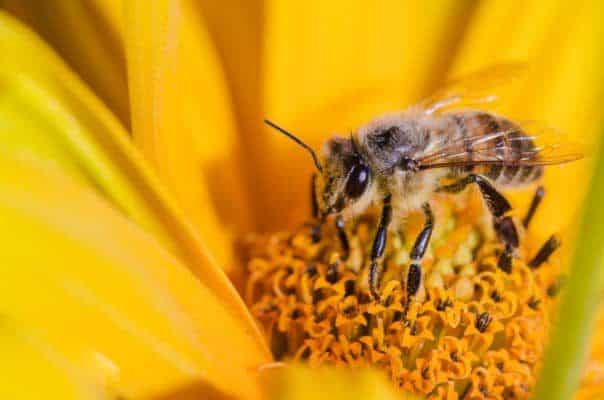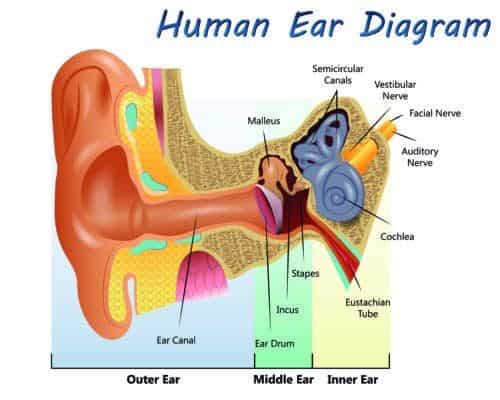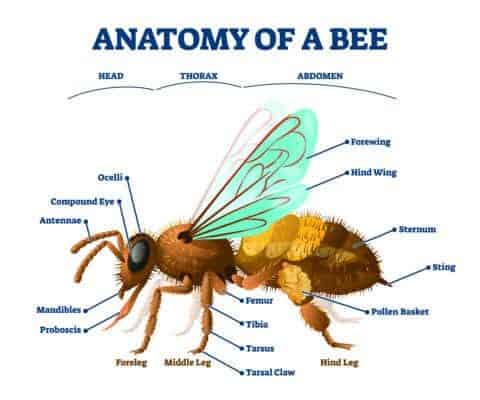Let’s cut to the chase: No, bees don’t have ears and they cannot hear – at least not in the way humans can. They do have the Johnston’s organ, in their antennae, which picks up sounds by sensing vibrations using special receptors. The Johnston’s organ interprets the vibrations as sound just like our ears do.

So we know that bees don’t have ears. Stay with us as we take a deeper look into how bees use their antennae to hear or feel what’s going on in their world.
Human hearing vs Bee hearing
Sound is the vibration of air – our hearing involves picking up sounds waves (vibrations) of varying decibels by eardrums, the conversions of these sounds into nerve impulses, and interpretation of the sounds by our brain.

So, how are bees able to pick up sounds to achieve the equivalent sense of ‘hearing’?
For a long time, it has been considered that bees are deaf to airborne vibrations. But the truth is that intra-colony communication among honey bees is achieved with the help of vibroacoustic. This is the process whereby the body is used to pick up sound vibrations.
Johnston’s organ is a chordotonal organ situated in the second segment of insects’ antenna that has been revealed to be used in detecting sound vibrations. The function of Johnston’s organ is to detect the vibrations or sound waves gathered by insects’ antennas.
For more information on bee antennae, we have another article, Bee Antennae, An Amazing Sensory Super Highway
With airborne sounds, bees are capable of detecting the air-particle movements. This is beneficial since bees generate sounds when moving their wings and thoracic muscles.
Bees uncouple their wings to produce heat hence generating acoustic signals, although they use the same muscles in moving their wings. It is important to note that the pressure and particle movement is what traveling sound waves are, and are measured in Hertz (Hz) by their frequency, or cycles/second.
According to Frisch (2013), bees are known to generate various vibrations and sounds – from about 10 to over 1000Hz. The higher the wave frequency the higher the pitch and they are capable of detecting sound frequencies of close to 500Hz which is quite extraordinary.
Bees also have subgenual organs that are located in the tibia of their legs. The subgenual organs are involved in sound perception and are responsible for aiding bees to detect tones as vibration.

In the image above you can see some basic leg anatomy for the honey bee. If you are interested in more information on the honey bee’s legs check out this article we have, Do Bees Actually Have Knees? Kinda And More Than You Think.
Physical Bee Communication
How does the sound picking process help bees in their day to day activities, you wonder? Well, bees’ nestmates get information on the location of food sources using the airborne near-field sound vibrations and Substrate-Borne Vibration that involves a dance that is famously known as ‘honey bee waggle dance’.
The Waggle Dance
When a scout bee comes across an attractive nectar location, it goes to the hive carrying some to recruit other bees to harvest nectar from the same location.
The recruitment of the foragers starts when the scout bee returns to the hive bloated with forage from a newly found source of nectar. The scout bee starts by spending 30 to 45seconds regurgitating and sharing its nectar to the bees waiting in the hive.
Once its generosity gains a sizable audience the waggle dancing starts. The waggle dance involves tail-wagging with a transitional form referred to as the sickle dance.
The quantity and quality of the source of the food determine the liveliness and pace of the dances. If the source of nectar is of admirable quality, almost all scout bees dance enthusiastically and longer each time they return to the hive with the forage.
Meanwhile lower quality food sources induce fewer, shorter, and sluggish dances; hence recruiting fewer new nectar foragers.
The dancing bee is able to waggle its abdomen and vibrate its wings during forager recruitment dances. In doing so, it simultaneously generates substrate-borne vibrations, proximal field sounds, and jets of air that all transmit information from the dancing bee to the bees that are about to be recruited.
This makes it relatively simple for them to successfully convey their message content to other bees in a timely and effective way.
Consequently, the newly recruited bees are accordingly guided to their target food location.
Sound Picking in the Waggle Dance
- Air-Borne Vibration
Other than observing the dancing bees, nearby forage recruits may pick small sounds emitted by the dancing bees to obtain information.
The sound and airflows that are generated by the dancer bee’s wings and abdominal vibrations are important cues of sound picking in bees, but the decoding process for these dance messages are not well understood.
In quest of understanding the waggle dance’s neural communication mechanisms, researchers have in the past analyzed the antenna and Johnston’s organ anatomy, as well as the neural and the mechanical response of Johnston’s organ and bee antenna to acoustic (waggle dance) stimuli respectively.
Johnston’s organ in bee comprises around 300 to 320 scolopidia attached to about 48 circular “knobs” in the pedicel circumference.
Each scolopidium holds bipolar sensory neurons that contain cilia of both Type I and Type II. The antennal flagellum’s mechanical sensitivities are particularly high in responses towards low but not high-intensity stimuli of around 265-350Hz frequencies.
During the waggle dance, the dancing bee moves its body in 15Hz waggling movements while vibrating its wings in short pulses (20ms duration at 200 to 300 Hz frequencies (Tautz 2008).
These wing vibrations produce feeble near-field sounds that may be detected by forage recruits when they are close to the dancing bee.
- Substrate-Borne Vibration
Other than the airborne sound signals among the bees, substrate-borne vibration signals are also used in communication among worker bees. The substrate-borne vibrations are picked by subgenual organs in bees’ legs.
These subgenual organs are basically chordotonal organs in each leg’s tibia, just adjacent to the femur and tibia joint. Each of the subgenual organs is held in a channel of hemolymph.
The subgenual organs receive and pick (sense) the substrate vibrations (sound) through the bees’ legs, and translate them into nerve impulses that are in turn transmitted to the bees’ CNS (central nervous system) for response formulation.
Also, waggle dance enhances thoracic vibrations transmission to the substrate, with a maximum signal transmitted when the thorax of the bee is fully laterally displaced.
Varied bee’s legs postures perceive both vertical and horizontal components of the substrate vibrations, and vibrations are transformed into neural impulses through the subgenual organ.
Waggle dances are more frequent in honeycomb open cells than on capped cells, with the dances in open cells strongly attracting inactive potential recruits – an indication that substrate properties are vital components of signal transmission.
Although substrate vibrations transmit information from the waggling bee to the audience bees during waggle dancing, they may not give specific information concerning the direction and velocity of the dancing bee during the waggle dance.
- Intra-specific communication
Intra-specific communication involves various vibration signals transmitted via the honeycomb. The best known such signals are the quacking and tooting signals produced by the queen bee and the ‘stop’ signal produced by the worker bees. All these signals have fundamental frequencies ranging from 200 to 500Hz, but the different temporal structure (Tautz 2008).
Honey bees also communicate through pheromones. It is really fascinating how tens of thousands of bees in a hive can work seamlessly as a superorganism. If you are interested in understanding how this happens check out this article we have on the topic. How Do Bees Communicate?
The Wrap Up
Despite lacking ears, having a comprehensible overview of how bees pick sounds, transform them into nerve impulses, and process them in a useful way is quite captivating.
This may help us to realize just how hearing works, and numerous researchers have taken this information to formulate new and innovative ways to help people with hearing problems.
References
Frisch, K. v. (2013). The Dance Language and Orientation of Bees. Cambridge: Harvard University Press.
Tautz, J. (2008). The Buzz about Bees- Biology of a Super-organism. Munich: Springer.
